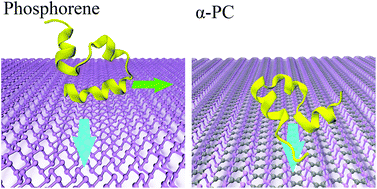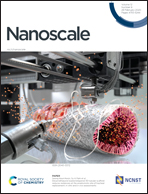Anisotropic protein diffusion on nanosurface†
Abstract
The unique puckered structure of α-phase phosphorene carbide (α-PC) results in anisotropic electronic and thermal transporting properties. In the present work, the interactions between a model protein, villin headpiece sub-domain (HP35), and the surface of α-PC and monolayer black phosphorus (MBP, another puckered nanostructure) were explored by molecular dynamic (MD) simulations. It is found that HP35 diffuses quickly only along the zigzag direction of the α-PC surface. On the MBP surface, HP35 migrates mainly along the zigzag direction but can also easily stride over the ridges and grooves along the armchair direction. Moreover, the mild binding strength between α-PC and HP35 does not cause distortion in the protein structure. The intrinsic biocompatibility of α-PC, which is distinct from several other widely studied nanomaterials, such as carbon nanotubes, graphene and MoS2, makes it a promising candidate in functional biomedical applications.

- This article is part of the themed collection: Theoretical Modelling at Nano-bio Interfaces


 Please wait while we load your content...
Please wait while we load your content...